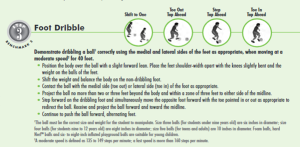| Equipment | Set-Up | |
|---|---|---|
| Skill Development Equipment/Set-up |
|
|
Skill Development: Foot Dribble
This skill development focuses on instruction and practice of moving the ball with the feet (Foot Dribbling) The second grade GLO is to dribble with the feet in the general space with control of the ball and body. The EPEC Classic TLP foot dribble is used for instruction and form corrections, with a focus on steps 1-4.
Prepare:
Say to students:
- Now
- Today we are going to focus on moving the ball all around with both of our feet.
- You probably remember practicing this skill last year.
- Which skill do you think I am talking about? (Foot Dribbling)
- Yes, you are right! We are going to focus on improving our skill at foot dribbling.
- Getting better at this skill will help you to participate well in games like soccer.
- Remember that whenever we are using a ball, we are going to try to use safe equipment handling/responsibility.
- Raise your hand if you can recall one of the safety cues I might use while we are working with a ball. (e.g., freeze please, foot to ball, eyes on me, etc.)
- Also, we want to work well with our practice partners so that we can have the best practice possible.
Explain/Demonstrate: Foot Dribble/Foot Trap
- Ask half of the students to move to a spot and stand with their feet apart on either side of the spot.
- Ask the other half to stand one arm’s length behind a student who is already on a spot to be their practice partner.
- Review with students:
- The ready position for foot dribble
- Which parts of the foot will be used while dribbling (medial and lateral)
- The force needed on the ball to move it properly (soft foot tap)
- Remind students about using foot trapping to stop the ball if it begins moving too quickly or too far away from the dribbler.
Practice: Foot Dribble- Try for Ten- Toes Out
- Explain to students that they are going to try to dribble the ball ten taps in a row using the medial/inside part of their foot.
- After they have foot-dribbled forward ten times in a row, they can trap the ball, turn back toward their partner, and try to dribble to ten again on their return.
- After reaching their spot their partner can begin their try for ten.
- They should continue taking turns practicing with good ball and body control until they hear you cue aloud, freeze please.
- Start music to cue movement.
- Monitor and re-teach students as needed.
Practice: Foot Dribble- Try for Ten- Toes In
- Explain to students that now they are going to try to dribble the ball ten taps in a row using the lateral/outside of their foot.
- Explain that if they have not tried this before it can feel a bit tricky, but their goal is just to try their best until they are able to get ten in a row.
- After they have foot dribbled forward ten times in a row, they can trap the ball, turn back towards their partner, and try to dribble ten again on their return.
- After reaching their spot their partner can begin their try for ten.
- Start music to cue movement.
- Monitor and re-teach students as needed.

Explain/Demonstrate: Dot to Dot Dribble
- Share with students that now they are going to try to dribble their ball in different directions while trying to keep control.
- Place space spots throughout activity space, at least 3 to 6 feet apart from each other.
- Remind students that they did an activity like this before using their hand dribble and now they are going to try it with their feet.
- Explain that when the music starts, they may begin trying to dribble (using inside/outside of foot) to any one of the spots/dots.
- Share that when they make it to a spot, they should use their foot to trap the ball on top of it to stop it there. Then they should dribble to another spot/dot and trap the ball on top of that one.
- Explain that after they have traveled to three different spots, they can dribble back to their partner.
- After reaching their original spot, their partner can begin their dot-to-dot dribble practice.
- Remind students that many dribblers are going to be moving in many directions, so it will be important to have awareness and use body control, to keep control of the ball.
Practice: Dot to Dot Dribble
- Ask the first practice student to show readiness.
- Start music to cue movement.
- Monitor and call out reminder cues to help students to focus on good body form.
- Continue practicing for 1-2 minutes.
Transition:
Ask students to low five or pinky shake with their practice partner, return their ball to the designated area, and sit down in their team position.
| Variations: | Students can be paired together and take turns practicing, if space or amount of equipment is an issue. |
|---|